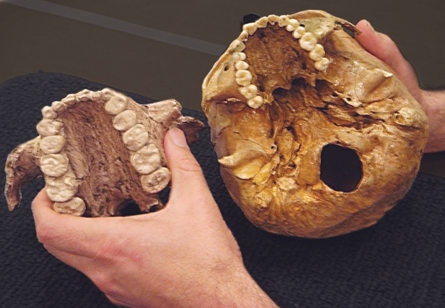A jut-jawed, peg-toothed member of humans’ evolutionary family has chemically vetoed its 50-year-old nickname — Nutcracker Man.

Far from eating nuts, seeds and other hard foods seemingly suited to its viselike jaws, this now-extinct hominid mainly munched grasses and flowering plants called sedges, which include papyrus, says a team led by geochemist Thure Cerling of the University of Utah in Salt Lake City.
Nutcracker Man, known formally as Paranthropus boisei, competed for food in swampy parts of East Africa with grazing animals such as ancestral zebras and pigs, Cerling’s team proposes in a paper published online the week of May 2 in the Proceedings of the National Academy of Sciences. Foods favored by its primate brethren, such as tree fruits, left P. boisei cold, the scientists suggest.
P. boisei, the final species in a side branch of human evolution, lived from around 2.3 million to 1.2 million years ago.
“We’re proposing a possible diet for P. boisei that is quite different from that of modern primates and is outside the range of what many researchers expected,” Cerling says.
His group’s report elaborates on two previous investigations suggesting that Nutcracker Man said “nuts” to nuts. Microscopic marks on this ancient hominid’s teeth denote a diet primarily consisting of soft foods, although initial suspicions focused on a taste for fruit, which would have been consistent with a primate diet (SN: 5/24/08, p.7).
Archaeologist Nikolaas van der Merwe of the University of Cape Town in South Africa and his colleagues reported in 2008 that two P. boisei teeth from Tanzanian sites contained chemical signatures of a diet rich in grasses and sedges. Analyzing the proportions of certain forms of carbon in animals’ teeth can distinguish between a taste for tree-based items such as fruits and nuts or for tropical grasses and sedges.
Van der Merwe welcomes the new study, which analyzes carbon in 24 teeth from 22 P. boisei individuals housed in Kenya. Government officials in Kenya had denied the South African scientist access to some of those specimens for his earlier carbon investigation.
Grasses grow seasonally in East Africa, so van der Merwe suspects that Nutcracker Man’s menu gravitated toward papyrus, a more dependable, year-round fixture of freshwater swamps that requires big teeth and considerable effort to chew.
“I don’t think P. boisei ate much grass,” van der Merwe says. “Sedges, particularly papyrus, get my vote.”
Cerling and his colleagues take no position on Nutcracker Man’s favorite food, emphasizing only that the ancient species was partial to grazing. Carbon measurements showed that among the 22 P. boisei individuals tested, the proportion of the diet consisting of grasses and sedges ranged from 61 percent to 91 percent.
Cerling plans to probe the carbon content of teeth from hominids between 3 million and 4 million years old for signs of previously unappreciated grass and sedge eating. P. boisei’s dietary lesson is simple, he says: The truth about teeth lies below the surface.






